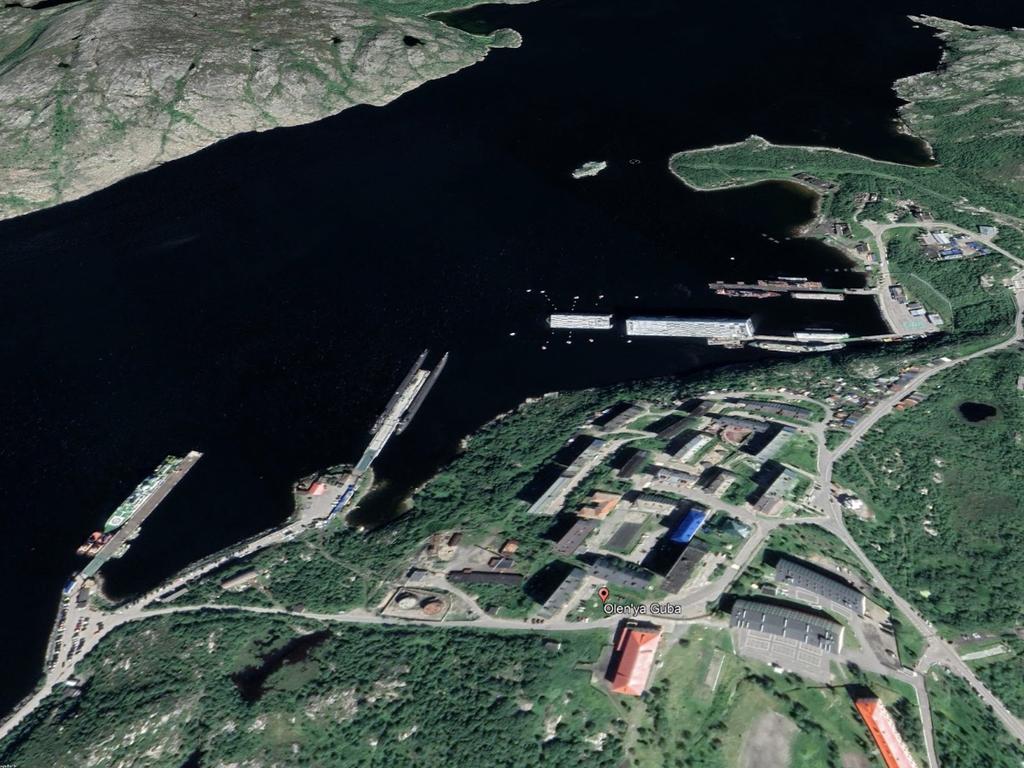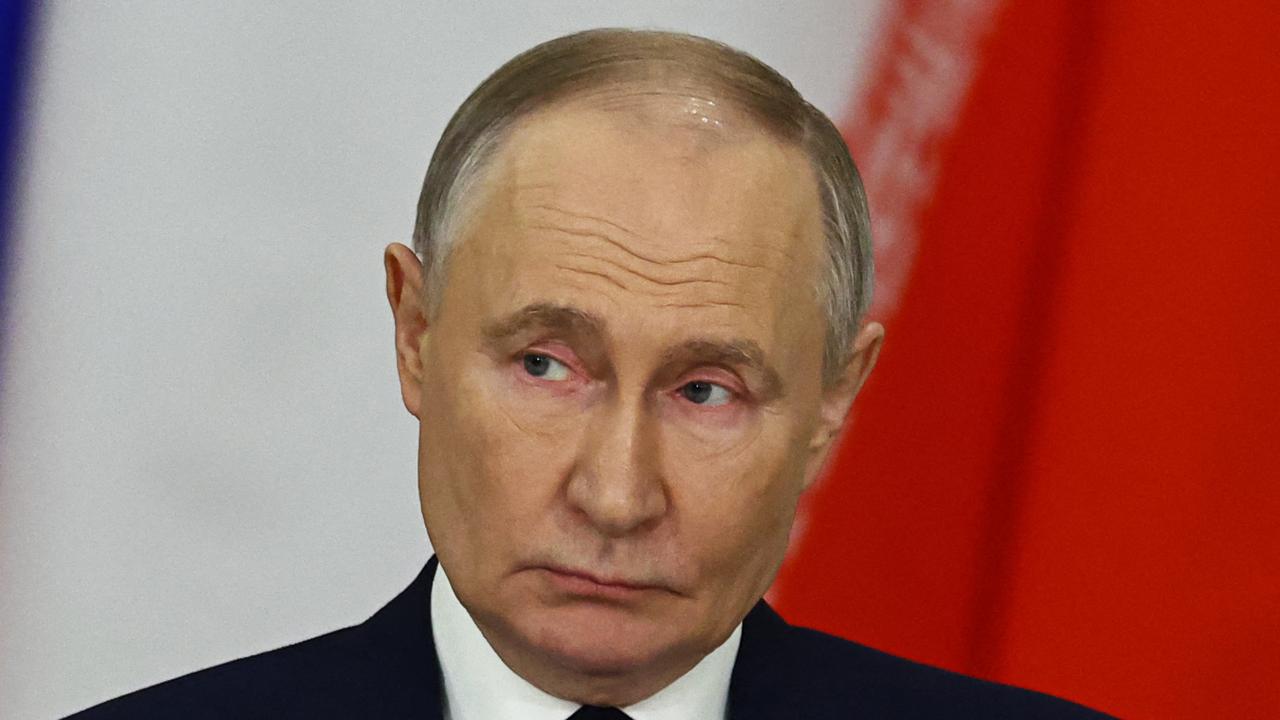Russia adds unusual defences to secretive Arctic navy base
Satellite images show Russia is beefing up the defences of its secretive Arctic Olenya Guba submarine base over 2000km from the Ukraine battlefield.

Satellite images show Russia is beefing up the defences of its secretive Arctic Olenya Guba submarine base. But it’s nowhere near Ukraine.
Russian trawlers appear to be fishing for internet cables. Its sailors have taken up an interest in drones, bridges and railway junctions. And a “spy whale” has been seen poling about the Baltic Sea even as more and more of its human comrades are being exposed across northern Europe.
In recent months, Norway, Finland and Sweden have all been sounding the alarm over this increased espionage activity. Even as NATO has noted an “upsurge” in Russian submarine activity in the North Atlantic.
So the sight of new defensive pontoons closing the bay leading to its secret spy and sabotage submarine facility near the city of Murmansk on the Arctic Circle is another piece in an already sinister pattern.
Sentinel-2 imagery of Olenya Guba earlier today shows that the Delta Stretch SSAN Podmoskovye was still missing, presumably at sea at that time.
— The Lookout (@The_Lookout_N) June 4, 2023
Interestingly, and can't remember seeing this here before, possible net/boom across the bay.
The Severodvinsk has departed. pic.twitter.com/BDjEOvwACx
Norwegian open source intelligence (OSINT) account “The Lookout” spotted the appearance of the 560-meter-long net and boom barrier while tracking the movements of Russian spy submarines in recent months.
One of President Vladimir Putin’s few new submarines – the nuclear-powered cruise missile carrying submarine Severodvinsk – slipped away from the dock sometime last week, according to an analysis of regularly updating Copernicus global satellite imaging data. The “stretched” nuclear-powered submarine Podmoskovye hasn’t returned since it departed last month.
Podmoskovye, an old Soviet Union-era ballistic missile submarine, underwent a significant reconstruction before being relaunched as a special operations mini-submarine carrier in 2015.
But the appearance of the new boom on satellite imagery has military analysts wondering why Moscow would want to harden its most sensitive Arctic base.


Hard-learned lessons
Several successful attacks by Ukrainian flying drones and drone boats on Russian ports, especially on the occupied Crimean Peninsula, have produced a rapid build-up of defences in these critical strategic assets.
Strengthened floating booms form floating barriers. Dangling nets are there to trap everything from torpedoes to small submersibles. Depth-charge launchers have been seen scattered among dockyard facilities. As have anti-aircraft gun and missile systems.
Sevastopol and Feodesia are once again safe havens for the cruise missile-carrying ships and submarines that played a significant role in attacking Ukrainian infrastructure in the opening stages of the war.
But why Moscow would want to replicate at least some of these defences far to the north remains a mystery.
Same pass, Olenya Guba.
— The Lookout (@The_Lookout_N) June 11, 2023
The Delta Stretch SSAN Podmoskovye is still missing, presumably out somewhere. pic.twitter.com/4EwgWXMhnX
“If we compare the floating boom in Crimea to those in Olenya Guba, it is clear that it is a defence,” naval analyst H.I. Sutton writes for Naval News.
“It is not the type used to contain pollution or some other prosaic explanation. Russia is hardening its key base in the Arctic.”
Olenya Guba is an off-limits facility run by the Russian Navy’s Main Directorate of Deep Sea Research (GUGI). This unit is responsible for the operation of Moscow’s deep-diving sabotage submarines, such as the nuclear-powered Losharik that suffered a fire that caused the death of at least 14 of its crew in 2019.
It is also responsible for the testing and deploying of one of President Putin’s new “superweapons” – the “Poseidon” nuclear tsunami torpedo.
But building up the facility’s defences is a sign of its increased significance to Moscow’s thinking.
“It is the type of move we might expect in war preparations,” writes Sutton. “However, in isolation, we should be cautious to read too much into it. But analysts will likely be watching other Russian Navy bases closely. Whatever the reason, it paints a picture of a Russian Navy increasingly concerned for its safety.”
Creating an Arctic’ crisis’
Climate change is heating the Arctic up to seven times faster than the rest of the planet. And as the ice retreats and permafrost softens, vast new mineral reserves and fish stocks are being opened up for exploitation.
Canada, Iceland, Norway, Denmark, Russia, China and the United States all want a piece of this new wealth.
Now Paul Goble of the international think tank The Jamestown Foundation believes Moscow may soon seek to manufacture a security crisis in the rapidly melting Arctic to counteract Beijing’s rapid economic expansion in the region.
A meeting between President Putin and Chairman Xi Jinping in March saw the announcement of a “working group” to develop a “Polar Silk Road”.
“But it is becoming increasingly obvious … that China’s plans are fundamentally at odds with those of the Kremlin and that these differences, along with China’s development of railway routes south of Russia through Central Asia and the Caucasus, mean that Beijing is more a competitor than an ally,” writes Goble.
“The current situation could lead the Kremlin to play up military tensions between Russia and the West to signal to China that it needs Russian military might in the Arctic to counter the West.”

Over the past decade, Moscow has upgraded more than 50 of its Arctic military facilities. And it’s built another three to cement its claim over territory as it becomes accessible.
Beijing insists that the rapidly forming Arctic sea must be open to all nations, and not fall under the control of any one country.
That’s the exact opposite of Moscow’s stance, says Goble. It wants to extend its exclusive economic zone (EEZ) across the Arctic. It is busily reinterpreting the United Nations Convention on the Law of the Sea (UNCLOS) to justify this.
“China wants Russia’s backing on Beijing’s insistence of a large exclusion zone in the South China Sea, even as the Chinese refuse to recognise Russian claims to such a zone in the Arctic,” says Goble.
“As tensions over Taiwan heat up, Moscow will have every reason to remind China that it needs Russian military might in the North to ensure that the Bering Straits and the sea lanes around Wrangel Island remain open to Chinese shipping.”




